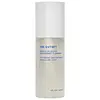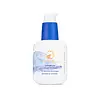What's inside
What's inside
 Key Ingredients
Key Ingredients

 Benefits
Benefits

 Concerns
Concerns

No concerns
 Ingredients Side-by-side
Ingredients Side-by-side

Water
Skin ConditioningGlycerin
HumectantPropanediol
SolventDecyl Glucoside
CleansingCaprylyl Caprylate
EmollientCaprylyl Glucoside
CleansingCassia Angustifolia Seed Polysaccharide
Skin ConditioningChamomilla Recutita Flower Extract
MaskingHelianthus Annuus Extract
EmollientCitrus Aurantium Dulcis Fruit Water
MaskingCitrus Limon Fruit Water
MaskingHelianthus Annuus Seed Oil
EmollientPersea Gratissima Oil
Skin ConditioningVitis Vinifera Seed Oil
EmollientRosmarinus Officinalis Leaf Extract
AntimicrobialPyrus Malus Fruit Extract
Skin ConditioningOryza Sativa Bran Extract
Skin ConditioningSerine
MaskingAlanine
MaskingGlycine
BufferingLysine Hcl
Skin ConditioningThreonine
Arginine
MaskingProline
Skin ConditioningHydrogenated Palm Glycerides Citrate
EmollientHeptyl Glucoside
Phenoxyethanol
PreservativeDehydroxanthan Gum
Emulsion StabilisingCoco-Glucoside
CleansingGlyceryl Oleate
EmollientCaprylyl Glycol
EmollientGlutamic Acid
HumectantPCA
HumectantCitric Acid
BufferingTrisodium Ethylenediamine Disuccinate
Tocopherol
AntioxidantBetaine
HumectantPotassium Hydroxide
BufferingPotassium Sorbate
PreservativeSodium Benzoate
MaskingSodium Lactate
BufferingSodium PCA
HumectantWater, Glycerin, Propanediol, Decyl Glucoside, Caprylyl Caprylate, Caprylyl Glucoside, Cassia Angustifolia Seed Polysaccharide, Chamomilla Recutita Flower Extract, Helianthus Annuus Extract, Citrus Aurantium Dulcis Fruit Water, Citrus Limon Fruit Water, Helianthus Annuus Seed Oil, Persea Gratissima Oil, Vitis Vinifera Seed Oil, Rosmarinus Officinalis Leaf Extract, Pyrus Malus Fruit Extract, Oryza Sativa Bran Extract, Serine, Alanine, Glycine, Lysine Hcl, Threonine, Arginine, Proline, Hydrogenated Palm Glycerides Citrate, Heptyl Glucoside, Phenoxyethanol, Dehydroxanthan Gum, Coco-Glucoside, Glyceryl Oleate, Caprylyl Glycol, Glutamic Acid, PCA, Citric Acid, Trisodium Ethylenediamine Disuccinate, Tocopherol, Betaine, Potassium Hydroxide, Potassium Sorbate, Sodium Benzoate, Sodium Lactate, Sodium PCA
Water
Skin ConditioningGlycerin
HumectantOryza Sativa Extract
AbsorbentDecyl Glucoside
CleansingSodium Cocoyl Glutamate
CleansingAloe Barbadensis Leaf Juice
Skin ConditioningCaprylyl/Capryl Glucoside
CleansingVitis Vinifera Seed Oil
EmollientHippophae Rhamnoides Fruit Oil
Skin ProtectingCocos Nucifera Fruit Extract
EmollientBrassica Oleracea Italica Seed Oil
EmollientCamellia Oleifera Seed Oil
Skin ConditioningLinum Usitatissimum Seed Oil
PerfumingSaccharomyces/Xylinum/Black Tea Ferment
Skin ConditioningLactobacillus Ferment
Skin ConditioningLactobacillus Ferment Lysate
Skin ConditioningLactobacillus
Skin ConditioningCoco-Glucoside
CleansingVinegar
Tocopherol
AntioxidantGlucose
HumectantHydrogenated Palm Glycerides Citrate
EmollientCitric Acid
BufferingGlyceryl Oleate
EmollientXanthan Gum
EmulsifyingCarrageenan
Leuconostoc/Radish Root Ferment Filtrate
AntimicrobialSodium Benzoate
MaskingPotassium Sorbate
PreservativeSodium Dehydroacetate
PreservativeSodium Phytate
Water, Glycerin, Oryza Sativa Extract, Decyl Glucoside, Sodium Cocoyl Glutamate, Aloe Barbadensis Leaf Juice, Caprylyl/Capryl Glucoside, Vitis Vinifera Seed Oil, Hippophae Rhamnoides Fruit Oil, Cocos Nucifera Fruit Extract, Brassica Oleracea Italica Seed Oil, Camellia Oleifera Seed Oil, Linum Usitatissimum Seed Oil, Saccharomyces/Xylinum/Black Tea Ferment, Lactobacillus Ferment, Lactobacillus Ferment Lysate, Lactobacillus, Coco-Glucoside, Vinegar, Tocopherol, Glucose, Hydrogenated Palm Glycerides Citrate, Citric Acid, Glyceryl Oleate, Xanthan Gum, Carrageenan, Leuconostoc/Radish Root Ferment Filtrate, Sodium Benzoate, Potassium Sorbate, Sodium Dehydroacetate, Sodium Phytate
Ingredients Explained
These ingredients are found in both products.
Ingredients higher up in an ingredient list are typically present in a larger amount.
Citric Acid is an alpha hydroxy acid (AHA) naturally found in citrus fruits like oranges, lemons, and limes.
Like other AHAs, citric acid can exfoliate skin by breaking down the bonds that hold dead skin cells together. This helps reveal smoother and brighter skin underneath.
However, this exfoliating effect only happens at high concentrations (20%) which can be hard to find in cosmetic products.
Due to this, citric acid is usually included in small amounts as a pH adjuster. This helps keep products slightly more acidic and compatible with skin's natural pH.
In skincare formulas, citric acid can:
While it can provide some skin benefits, research shows lactic acid and glycolic acid are generally more effective and less irritating exfoliants.
Most citric acid used in skincare today is made by fermenting sugars (usually from molasses). This synthetic version is identical to the natural citrus form but easier to stabilize and use in formulations.
Read more about some other popular AHA's here:
Learn more about Citric AcidCoco-Glucoside is a surfactant, or a cleansing ingredient. It is made from glucose and coconut oil.
Surfactants help gather dirt, oil, and other pollutants from your skin to be rinsed away.
This ingredient is considered gentle and non-comedogenic. However, it may still be irritating for some.
Learn more about Coco-GlucosideDecyl Glucoside is a glucose-based surfactant and emulsion stabilizer. It is created by reacting glucose with the fatty acids from plants.
Surfactants help clean the skin by trapping oil, sebum, and dirt to be washed away. As an emulsion stabilizer, it stabilizes the ingredients in a product by preventing them from separating.
This ingredient is biodegradable and non-toxic. This ingredient is commonly found in baby shampoos.
Decyl Glucoside is sometimes used to stabilize the UV filter Tinosorb.
Learn more about Decyl GlucosideGlycerin is already naturally found in your skin. It helps moisturize and protect your skin.
A study from 2016 found glycerin to be more effective as a humectant than AHAs and hyaluronic acid.
As a humectant, it helps the skin stay hydrated by pulling moisture to your skin. The low molecular weight of glycerin allows it to pull moisture into the deeper layers of your skin.
Hydrated skin improves your skin barrier; Your skin barrier helps protect against irritants and bacteria.
Glycerin has also been found to have antimicrobial and antiviral properties. Due to these properties, glycerin is often used in wound and burn treatments.
In cosmetics, glycerin is usually derived from plants such as soybean or palm. However, it can also be sourced from animals, such as tallow or animal fat.
This ingredient is organic, colorless, odorless, and non-toxic.
Glycerin is the name for this ingredient in American English. British English uses Glycerol/Glycerine.
Learn more about GlycerinGlyceryl Oleate is the ester of glycerin and oleic acid. This ingredient is mainly an emollient and emulsifier.
Emollients soften and hydrate the skin by creating a thin film on top to trap in moisture. As an emulsifier, glyceryl oleate helps stabilize formulations by preventing ingredients such as oil and water from separating. According to a manufacturer, this ingredient helps helps thicken water-in-oil formulations, shower gels, and hair shampoos.
In some products, this ingredient may be used as a fragrance / perfuming ingredient. The scent of this ingredient is described to be "waxy".
Glyceryl oleate is created from oils rich in oleic acid, such as peanut oil and olive oil.
This ingredient may not be malassezia folliculitis safe.
Learn more about Glyceryl OleateHydrogenated Palm Glycerides Citrate isn't fungal acne safe.
Potassium Sorbate is a preservative used to prevent yeast and mold in products. It is commonly found in both cosmetic and food products.
This ingredient comes from potassium salt derived from sorbic acid. Sorbic acid is a natural antibiotic and effective against fungus.
Both potassium sorbate and sorbic acid can be found in baked goods, cheeses, dried meats, dried fruit, ice cream, pickles, wine, yogurt, and more.
You'll often find this ingredient used with other preservatives.
Learn more about Potassium SorbateSodium Benzoate is a preservative. It's used in both cosmetic and food products to inhibit the growth of mold and bacteria. It is typically produced synthetically.
Both the US FDA and EU Health Committee have approved the use of sodium benzoate. In the US, levels of 0.1% (of the total product) are allowed.
Sodium benzoate works as a preservative by inhibiting the growth of bacteria inside of cells. It prevents the cell from fermenting a type of sugar using an enzyme called phosphofructokinase.
It is the salt of benzoic acid. Foods containing sodium benzoate include soda, salad dressings, condiments, fruit juices, wines, and snack foods.
Studies for using ascorbic acid and sodium benzoate in cosmetics are lacking, especially in skincare routines with multiple steps.
We always recommend speaking with a professional, such as a dermatologist, if you have any concerns.
Learn more about Sodium BenzoateTocopherol (also known as Vitamin E) is a common antioxidant used to help protect the skin from free-radicals and strengthen the skin barrier. It's also fat soluble - this means our skin is great at absorbing it.
Vitamin E also helps keep your natural skin lipids healthy. Your lipid skin barrier naturally consists of lipids, ceramides, and fatty acids. Vitamin E offers extra protection for your skin’s lipid barrier, keeping your skin healthy and nourished.
Another benefit is a bit of UV protection. Vitamin E helps reduce the damage caused by UVB rays. (It should not replace your sunscreen). Combining it with Vitamin C can decrease sunburned cells and hyperpigmentation after UV exposure.
You might have noticed Vitamin E + C often paired together. This is because it is great at stabilizing Vitamin C. Using the two together helps increase the effectiveness of both ingredients.
There are often claims that Vitamin E can reduce/prevent scarring, but these claims haven't been confirmed by scientific research.
Learn more about TocopherolVitis Vinifera Seed Oil comes from the grape vine. Grape seeds are a byproduct of creating grape juice or wine.
The components of grape seeds have many skin benefits. Research has found it to be antimicrobial and anti-inflammatory. It also contains many potent antioxidants such as Vitamin E , Vitamin C, proanthocyanidins, polyphenols, flavonoids, and anthocyanins. Proanthocyanidin has been shown to help even out skin tone.
Antioxidants help fight free-radical molecules. Free-radical molecules are capable of damaging our cells and other genetic material. Antioxidants help stabilize free-radicals by donating extra electrons. Grape seed extract may help reduce the signs of aging.
The antimicrobial properties of grape seed may help treat acne. However, more research is needed to support this claim.
Grape seed has also been found to help absorb UV rays. Grape seed extract should not replace your sunscreen.
The fatty acids of grape seed oil give it emollient properties. Emollients help soothe and soften your skin by creating a film. This film traps moisture within, keeping your skin hydrated.
Learn more about Vitis Vinifera Seed OilWater. It's the most common cosmetic ingredient of all. You'll usually see it at the top of ingredient lists, meaning that it makes up the largest part of the product.
So why is it so popular? Water most often acts as a solvent - this means that it helps dissolve other ingredients into the formulation.
You'll also recognize water as that liquid we all need to stay alive. If you see this, drink a glass of water. Stay hydrated!
Learn more about Water